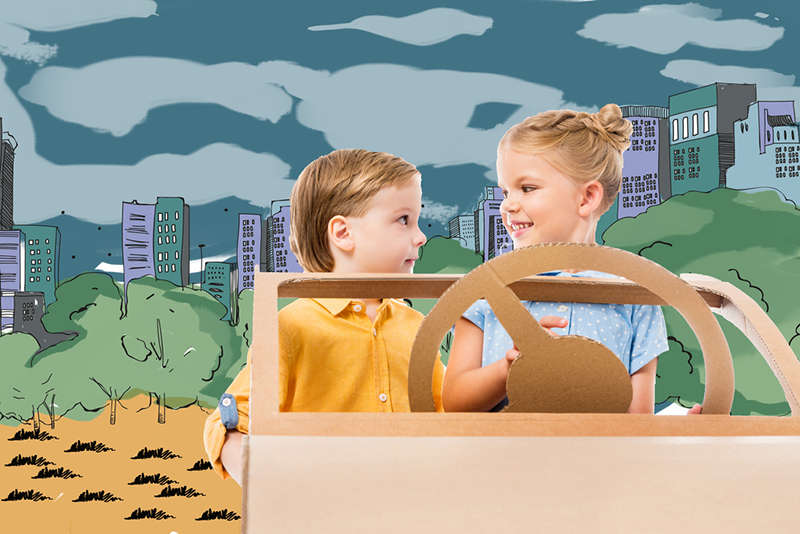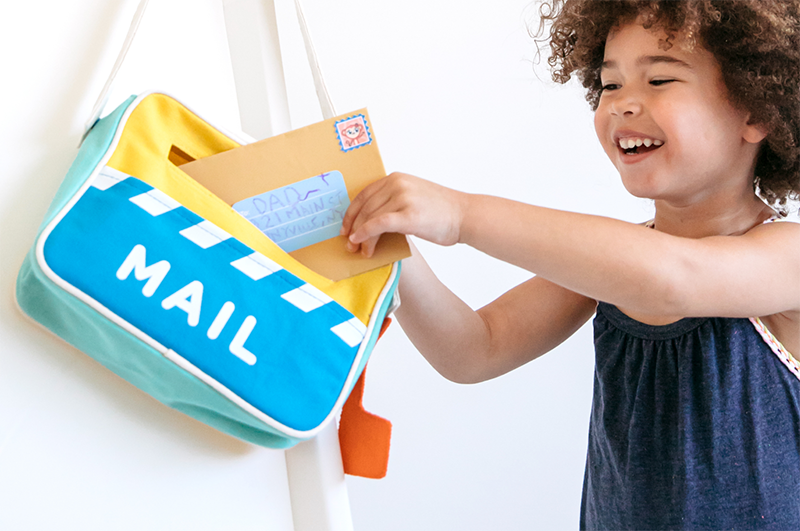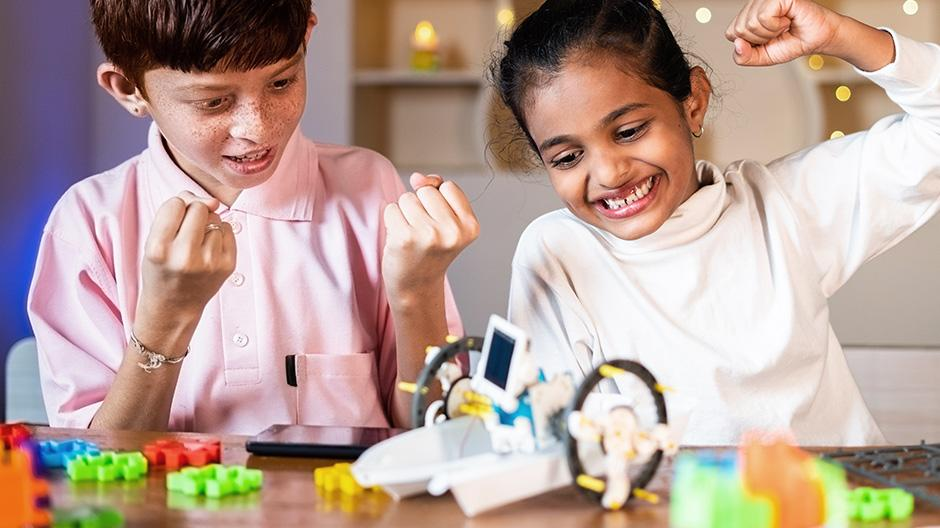Here at Begin, we value kids’ imaginations — a key ingredient in our educational approach that helps them learn and grow. We believe that all children are innately creative and imaginative, and it’s our job as parents and educators to help them tap into that power.
These expert tips can help you do just that. But before we dive into those, let’s define what we mean by imagination and discuss why it’s so important.
Table Of Contents
- What Is Imagination, Exactly?
- The Importance Of Kids’ Imagination
- 8 Activities To Encourage Kids’ Imagination
What Is Imagination, Exactly?

Imagination is the ability to create mental images and concepts of things that are not real. It’s often associated with creativity, the ability to see the world in new ways and develop original ideas.
And while adults easily distinguish between real and make-believe, young children often have a more challenging time making that distinction. For example, they might tell you an imaginary friend is real or believe a monster lives under their bed.
If your child is blurring the lines between reality and fiction, don’t be too worried. This way of thinking is perfectly normal! As they grow, they will gradually learn to tell the difference between imaginative and real events.
The Importance Of Kids’ Imagination
Now that we know what imagination is, let’s talk about why it is a crucial part of a child’s development.
A rich imagination provides all sorts of benefits for kids. It can help them learn and remember new information, improve their language skills, and boost their emotional intelligence.
Plus, creative thinking is an essential skill for future leaders and workers. After all, who can solve the world’s problems better than those who can think outside the box?
What Your Child Can Learn Through Imaginative Play

Kids learn through play and by using their imagination. They can explore different roles and try on different identities through make-believe games.
For example, they can use the HOMER Mail Adventure Learn and Play Kit and pretend they’re a mail carrier. (Consider printing this cute hat they can wear as they play!)
As kids engage in imaginative play, they can also experiment with different ways of thinking and problem-solving. They can try out various solutions and see what works best. And, if they make a mistake, that’s OK! It’s just part of the learning process.
Imaginative play also helps develop essential social and emotional skills. They learn how to cooperate with others, share, take turns, and resolve conflict. It also allows them to practice expressing difficult emotions, like fear and anger.
In other words, pretend play helps kids learn about themselves and their world.
8 Activities To Encourage Kids’ Imagination
Imagination, like other skills, can be nurtured. Here are eight fun activities to do with your child to help them use their imagination.
1) Ask “I Wonder” Questions
Asking your child open-ended questions is a great way to get their imagination going. These types of questions encourage kids to think creatively and come up with original ideas.
For example, you might say, “I wonder what would happen if we could fly,” or “I wonder why the sky is blue and not green.”
You can either talk about your answers together or take time to draw what you’re imagining. Drawing helps kids externalize their thoughts and makes it easier to share their ideas with others.
As you share your thoughts, listen to each other and show genuine interest in your child’s ideas. Then, ask follow-up questions to help them continue their line of thinking and provide more details.
2) Expand The Story

Read a book together, and then ask some questions to help kick your child’s imagination into overdrive. Here are a few ideas to get you started:
- How else could this story have ended?
- What would happen if this book took place in a different setting?
- Why do you think the character did (a specific action)? How would the book change if they had done something else instead?
If your child is older, encourage them to retell the story from another character’s viewpoint. For example, if you read “The Cat in the Hat,” they could pretend to be the cat and tell the story from his perspective.
You could even have them bring in characters from other stories and create a crossover adventure. This type of fan-fiction is an excellent way for kids to explore different plot lines and character dynamics as they build their imagination.
3) Model Imaginative Play

Kids learn best by example, so don’t be afraid to show them how it’s done!
Try letting your imagination run wild when you’re playing with your child. It doesn’t matter if you’re using toys, art supplies, or everyday objects — the important thing is that you’re using them in new and exciting ways.
For example, instead of just playing with toy cars or building blocks, use your imagination to really be the drivers or builders. You can also try playing a board game with new rules, creating your own board game, or turning your child’s stuffed animal collection into a zoo full of animals.
You can go anywhere using your imagination! Be creative, have fun, and start your child’s imagination on an adventure. Let them see that it’s OK to use their imagination and that there are no wrong answers.
4) Encourage Curiosity
When exploring the world, help your child see things in new ways and look at everything with a sense of wonder. For example, you might point out how leaves have different shapes or how a puddle can turn into a mini-pool if you add some rocks.
If you’re able, take time to foster their curiosity by taking them on field trips to interesting places, like the zoo, museum, or botanical gardens. No matter where you are, point out different things that catch your eye and encourage your child to ask questions about them.
If you help your child see the world as a place full of possibilities, they’ll be more likely to use their imagination when playing and creating.
5) Create A Story Box
Storytelling is a great way to encourage kids’ imagination, and a story box can be fun to get the creative juices flowing.
To make one, you’ll need a small box (shoebox size works well) and a variety of small items that your child can use to create a scene. These could be things like toy people or animals, shells, fabric scraps, buttons, etc.
Let them know they can use anything in the box to create a story. They can make up a tale about the characters and their adventures or even write down their story to share with you. If your child isn’t quite ready for writing a whole story, they can dictate their play and let you write!
If they’re having trouble, model how it’s done. Tell your own story using props from the box. Your child might start by mimicking your tale, and that’s OK! They’ll eventually develop their own style and ideas.
6) Look At Family Photos Together
Look at family photos together to spark ideas!
As you flip through the pages of a photo album or scroll through photos on your phone, point out different things you see and ask your child what they think was happening in the picture.
What do they think people were feeling? What do they think was going on just outside of the frame?
If you’re looking at recent pictures, ask your child to draw something they remember from that day that didn’t get captured in the photos.
7) Provide Empty Boxes

For some kids, the best way to encourage imagination is to provide them with a few simple materials and let them create. Empty boxes are perfect for this!
Kids can use them to make all sorts of things, like houses for their stuffed animals, a gas station for their toy cars, or a rocket to blast off to the moon. There are so many possibilities!
You can start with an end product in mind and ask your child to help you create it. Or, you can hand your child a box and a few basic art supplies and let them go to town. Both options will help build their imagination.
8) Have Regular Unscheduled Time
Finding time to relax and play can be hard in today’s busy world. But it’s important to give kids opportunities for unstructured, imaginative play.
That means setting aside some time each day (or week) for your child to play however they want. For example, they might like to play alone or invite you to join their game. Either way, resist the urge to take over or direct the play.
If your child has trouble coming up with ideas, offer a few suggestions to get them started. But let them take the lead and decide how the play will unfold.
Imagination Time!

Encouraging kids’ imagination is essential, and the above tips can help get you started. In addition, be sure to provide materials that foster creativity, such as the HOMER Mail Adventure Learn and Play Kit.
And for even more imaginative fun, download our Learn & Grow app. It provides your child with activities, games, and stories that spark creativity. Plus, it’s personalized to help your child learn at their own pace.
With a little guidance from you, your child’s imagination will be running wild in no time!













